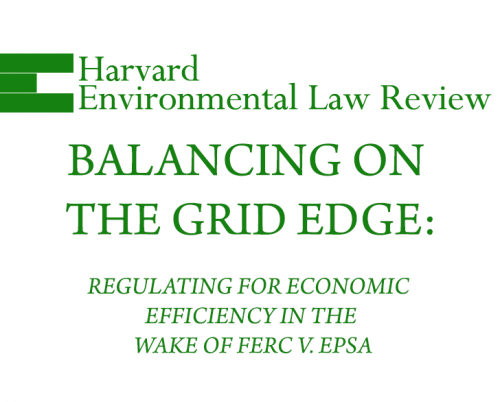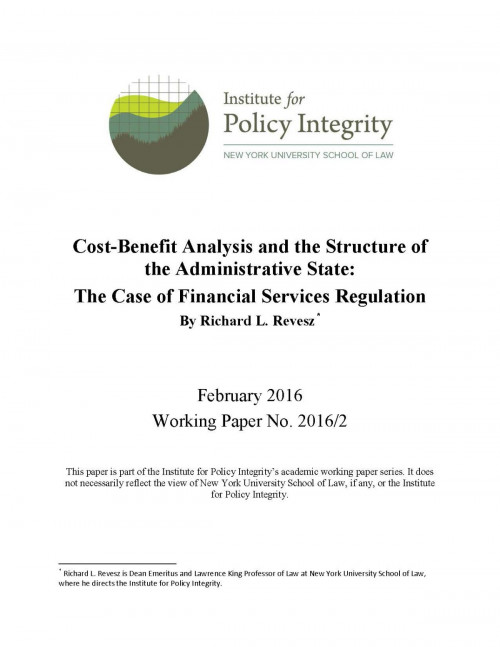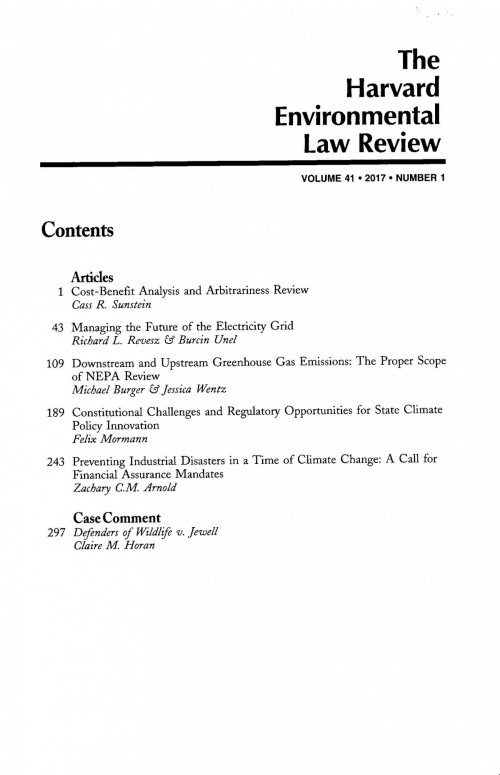-
Comments on Net Metering and Distributed Energy Valuation in New York
We recently submitted comments to the New York Public Service Commission on how the Commission should develop an interim successor to its net metering policy, and how distributed energy resources should be valued in the future. We filed the comments jointly with the Environmental Defense Fund. To begin to move the retail electricity markets toward efficient and accurate recognition of the value of distributed energy resources, we suggest that the Commission should enhance its existing net energy metering policy to align compensation with the system benefits provided by distributed energy resources; establish a fully unbundled retail price structure; and specifically account for the environmental benefits of distributed energy resources in future pricing structures.
-

Balancing on the Grid Edge
Regulating for Economic Efficiency in the Wake of FERC v. EPSA
This new article from senior attorney Denise Grab is featured in a special edition of the Harvard Environmental Law Journal that focuses on the Supreme Court’s FERC v. EPSA case.
-
Comments on FDA Proposal to Restrict Artificial Tanning
We recently submitted comments in response to the Food and Drug Administration’s (FDA) proposed rule to restrict the use of sunlamps used for artificial tanning. We concluded that although the proposed rule takes a significant step in reducing the risks of artificial tanning, the FDA should strengthen the justification for this proposed rule.
-
Brief for Clean Power Plan Litigation
We recently submitted an amicus brief in the litigation over the EPA’s Clean Power Plan, which regulates carbon dioxide emissions from the power sector. A group of coal companies and states is asking the U.S. Court of Appeals for the D.C. Circuit to strike down the rule, arguing that it represents an unprecedented expansion of the EPA’s regulatory authority. Our brief shows that, in fact, there are regulatory precedents for every aspect of the rule that petitioners claim is unprecedented. Our analysis of past EPA regulations and court rulings reveals that the Clean Power Plan is consistent with decades of Clean Air Act practice under administrations of both parties.
-

Cost-Benefit Analysis and the Structure of the Administrative State
The Case of Financial Services
The viability and desirability of conducting cost-benefit analysis of financial regulation is a subject of intense academic debate. Opponents claim that such analysis is feasible for environmental regulation but not for financial regulation because of the difference in the benefits that require monetization in the respective areas. This article, which will be published in a forthcoming edition of the Yale Journal on Regulation, argues that the recent debate misses an important part of the problem. In large part, cost-benefit analysis of financial regulation cannot currently be performed successfully because of institutional shortcomings, not analytical difficulties. Compared to Executive Branch agencies, independent agencies, like the major financial regulatory agencies, lack the capacity to do cost-benefit analyses of acceptable quality. Fortunately, there are good Executive Branch models that could be exported to the financial regulatory agencies.
-
Jayni Hein Addresses IEL’s Annual Oil and Gas Conference
On February 19th, our Policy Director, Jayni Hein, presented at the Institute for Energy Law’s Annual Oil and Gas Law Conference in Houston. Speaking on a panel titled “How Revenues Should be Collected for the Use of Federal Lands for Energy Development.”
-

Managing the Future of the Electricity Grid: Distributed Generation and Net Metering
As distributed energy generation is becoming increasingly common, the debate on how a utility’s customers should be compensated for the excess energy they sell back to the grid is intensifying. This article provides a thorough analysis of the benefits and the costs of distributed generation and highlights the analytical flaws and missing elements in the competing positions and in all the existing policies.
-
Brief for BLM Coal Lease Case
We recently submitted an amicus brief in a case challenging two large coal leases approved by the Bureau of Land Management (BLM). The case, WildEarth Guardians v. U.S. Bureau of Land Management, is being heard by the U.S. Court of Appeals for the 10th Circuit. We believe that BLM used an irrational assumption about coal supply and demand in its environmental impact statement for the Wright Area coal leases in the Powder River Basin in Wyoming. Because of this flawed assumption, BLM’s presentation of the climate consequences of leasing, versus taking no action, is inaccurate and misleading, in violation of the National Environmental Policy Act (NEPA).
-
Clean Power Plan - Comments on Federal Plan/Model Trading Rules
Concurrently with issuing its final Clean Power Plan to limit greenhouse gas emissions from existing power plants, the EPA issued a set of proposed federal plan requirements and model trading rules to provide states guidance as they determine their strategies to comply with the Clean Power Plan. We recently submitted comments to the agency on how these guidelines can be improved to best reduce compliance costs and promote effectiveness of the plan.
-
Revesz Named One of Most Influential Legal Educators
The National Jurist has named Richard Revesz to its list of the 25 “Most Influential People in Legal Education.”
